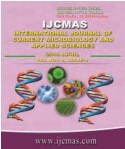


 National Academy of Agricultural Sciences (NAAS)
National Academy of Agricultural Sciences (NAAS)

|
PRINT ISSN : 2319-7692
Online ISSN : 2319-7706 Issues : 12 per year Publisher : Excellent Publishers Email : editorijcmas@gmail.com / submit@ijcmas.com Editor-in-chief: Dr.M.Prakash Index Copernicus ICV 2018: 95.39 NAAS RATING 2020: 5.38 |
To assess the impact of weather parameters on mustard aphid, a field experiment was conducted during Rabi season 2011-12 to 2017-18 at Main Castor-Mustard Research Station, S.D. Agricultural University, Sardarkrushinagar. The experiment was laid down in randomized block design consisting five varietal treatments viz. BSH-1, GSC-6, T-27, GS-1 and GDM-4 with three replications. The crop was sown during 24th – 30th Sept as timely sown crop and 15th – 21st Oct as late sown crop. The results revealed that the maximum incidence of aphid was observed in late sown crop as compared to early sown crop. The correlation study between aphid population and weather parameters revealed that the maximum temperature (Tmax), minimum temperature (Tmin) and growing degree days (GDD) had significant negative correlation with aphid population. Morning relative humidity, evening relative humidity, sunshine hours and wind speed did not have significant correlation with aphid population. The regression models were developed with Tmax and GDD could explain 72 to 87 percent variation in aphid population in different cultivars.
 |
 |
 |
 |
 |